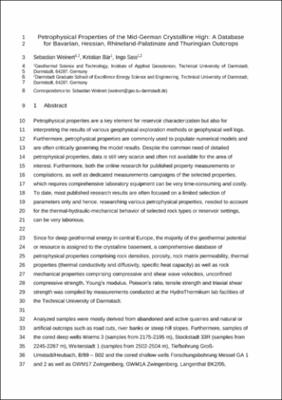Petrophysical Properties of the Mid-German Crystalline High: A Database for Bavarian, Hessian, Rhineland-Palatinate and Thuringian Outcrops
Description
Petrophysical properties are a key element for reservoir characterization but also for interpreting the results of various geophysical exploration methods or geophysical well logs. Furthermore, petrophysical properties are commonly used to populate numerical models and are often critically governing the model results. Despite the common need of detailed petrophysical properties, data is still very scarce and often not available for the area of interest. Furthermore, both the online research for published property measurements or compilations, as well as dedicated measurements campaigns of the selected properties, which requires comprehensive laboratory equipment can be very time-consuming and costly. To date, most published research results are often focused on a limited selection of parameters only and hence, researching various petrophysical properties, needed to account for the thermal-hydraulic-mechanical behavior of selected rock types or reservoir settings, can be very laborious. Since for deep geothermal energy in central Europe, the majority of the geothermal potential or resource is assigned to the crystalline basement, a comprehensive database of petrophysical properties comprising rock densities, porosity, rock matrix permeability, thermal properties (thermal conductivity and diffusivity, specific heat capacity) as well as rock mechanical properties comprising compressive and shear wave velocities, unconfined compressive strength, Young’s modulus, Poisson’s ratio, tensile strength and triaxial shear strength was compiled by measurements conducted at the HydroThermikum lab facilities of the Technical University of Darmstadt. Analyzed samples were mostly derived from abandoned and active quarries and natural or artificial outcrops such as road cuts, river banks or steep hill slopes. Furthermore, samples of the cored deep wells Worms 3 (samples from 2175-2195 m), Stockstadt 33R (samples from 2245-2267 m), Weiterstadt 1 (samples from 2502-2504 m), Tiefbohrung Groß-Umstadt/Heubach, B/89 – B02 and the cored shallow wells Forschungsbohrung Messel GA 1 and 2 as well as GWM17 Zwingenberg, GWM1A Zwingenberg, Langenthal BK2/05, EWS267/1 Heubach, and archive samples of the Institut für Steinkonservierung e. V. in Mainz originating from a comprehensive large scale sampling campaign in 2007. The database aims to provide easily accessible petrophysical properties of the Mid-German Crystalline High, measured on 224 locations in Bavaria, Hesse, Rhineland-Palatinate and Thuringia and comprising 26,952 single data points. Each data point is addressed with the respective metadata such as sample identifier, sampling location, petrography and if applicable stratigraphy and sampling depth (in case of well samples). The presented database accompanies an additional paper (Weinert et al. 2020, in preparation) in which the applied methods, the general database structure, quality control as well as further information on sampling locations and sample coverage of the Mid-German Crystalline High is given. Acknowledgements: The authors thank the Institut für Steinkonservierung e. V. for providing their archive samples for analyzation. Further, the authors are thankful to the Bundesverband Erdgas, Erdöl und Geoenergie e. V. (BVEG) as well as BEB Erdgas und Erdöl GmbG & Co. KG, the owner of the wells, for providing core samples of the crystalline basement for investigation and publishing. As research assistants Alexander Lambert, Christian Schneider and Stina Krombach helped in measuring the presented data. The authors are further thankful for the help of Florent Dutheillet de Lamothe within the framework of his internship at Technical University of Darmstadt. Also, the authors are grateful for contributions of Bianca Vogel, Alexander Lambert, Rafael Schäffer, Helmuth Hoffmann, Romain Maire, Alexej Philipp, Johanna Rüther, Jan Niklas Weger, Ulrike Klaeske, Liang Pei, and Hendrik Biewer in the framework of their conducted theses. Furthermore, the authors thank for the financial support by the DFG in the framework of the Excellence Initiative, Darmstadt Graduate School of Excellence Energy Science and Engineering (GSC 1070) as well as the Federal Ministry for Economic Affairs and Energy for financing the present research in the scope of Hessen 3D 2.0 (funding number 0325944A)
Subject
Petrophysical Properties;Mid German Crystalline High;Outcrop Analogue Study;Petrothermal Systems;Enhanced Geothermal SystemsDFG subject classification
3.42-01 Geologie3.43-01 Physik des Erdkörpers
3.46-01 Hydrogeologie, Hydrologie, Limnologie, Siedlungswasserwirtschaft, Wasserchemie, Integrierte Wasserressourcen-Bewirtschaftung
URI
https://tudatalib.ulb.tu-darmstadt.de/handle/tudatalib/2433https://doi.org/10.25534/tudatalib-278
Collections
The following license files are associated with this item:


